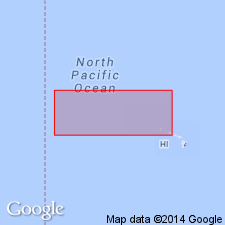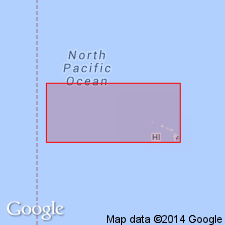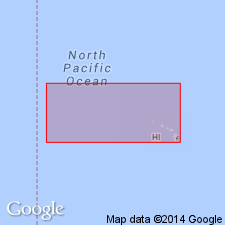
- Usage in publication:
-
- Pearl River series
- Modifications:
-
- Named
- Dominant lithology:
-
- Limestone
- AAPG geologic province:
-
- Oahu
Hitchcock, C.H., 1900, Geology of Oahu: Geological Society of America Bulletin, v. 11, p. 15-60.
Summary:
Named for best development about Pearl River which drains into Pearl Harbor on south side of Oahu. [no type designated.] Consists of series of marine deposits, reefs, decayed rock, secondary volcanic products, ashes, and basalt about 1000 ft thick. At railway cutting east Waipo station west of Pearl City section includes beds of oyster shells, 1 to 2 ft thick. It is concluded that reef rock of Pearl Harbor and Diamond Head limestones are of late Tertiary age, which may correspond to Pliocene of west American shores (W.H. Dall, p.60 [Dall refers to beds as "Pearl Harbor formation"].
Source: GNU records (USGS DDS-6; Menlo GNULEX).

- Usage in publication:
-
- Pearl Harbor series
- Modifications:
-
- Redescribed
- AAPG geologic province:
-
- Oahu
Hitchcock, C.H., 1911, Hawaii and Its volcanoes: Hawaiian Gazette Co., 2nd edition, 314 p.
Summary:
Pearl River series (Hitchcock, 1900) is here termed "Pearl Harbor Series". Whole assemblage is "really a terrane" about 1000 ft thick. Best developed near Pearl River locks. This series of coral reefs and limestones associated with sedimentary deposits and volcanic flows probably began in Pliocene.
Source: GNU records (USGS DDS-6; Menlo GNULEX).

- Usage in publication:
-
- Pearl River series
- Modifications:
-
- Not used
- Age modified
- AAPG geologic province:
-
- Oahu
Summary:
Neither name (Pearl River series or Pearl Harbor series) is any longer used. Stearns (1935, p.165-172) discusses rocks under head "Quaternary sedimentary rocks". Unit is locally interbedded with flows of Honolulu volcanic series. Overlies with erosional unconformity lavas of Koolau and Waianae volcanic series. Assigned Pleistocene and Recent age based on pelecypods (Ostergaard, 1928).
Source: GNU records (USGS DDS-6; Menlo GNULEX).
For more information, please contact Nancy Stamm, Geologic Names Committee Secretary.
Asterisk (*) indicates published by U.S. Geological Survey authors.
"No current usage" (†) implies that a name has been abandoned or has fallen into disuse. Former usage and, if known, replacement name given in parentheses ( ).
Slash (/) indicates name conflicts with nomenclatural guidelines (CSN, 1933; ACSN, 1961, 1970; NACSN, 1983, 2005, 2021). May be explained within brackets ([ ]).

